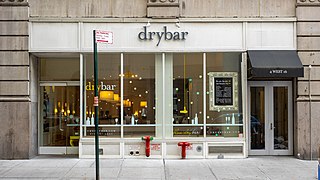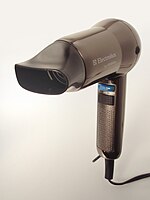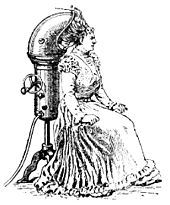
A hairstyle, hairdo, haircut or coiffure refers to the styling of hair, usually on the human head but sometimes on the face or body. The fashioning of hair can be considered an aspect of personal grooming, fashion, and cosmetics, although practical, cultural, and popular considerations also influence some hairstyles.

A clothes dryer, also known as tumble dryer, is a powered household appliance that is used to remove moisture from a load of clothing, bedding and other textiles, usually after they are washed in a washing machine.
Nichrome is a family of alloys of nickel and chromium commonly used as resistance wire, heating elements in devices like toasters, electrical kettles and space heaters, in some dental restorations (fillings) and in a few other applications.

A hairbrush is a brush with rigid or light and soft spokes used in hair care for smoothing, styling, and detangling human hair, or for grooming an animal's fur. It can also be used for styling in combination with a curling iron or hair dryer.

Hair conditioner is a hair care cosmetic product used to improve the feel, texture, appearance and manageability of hair. Its main purpose is to reduce friction between strands of hair to allow smoother brushing or combing, which might otherwise cause damage to the scalp. Various other benefits are often advertised, such as hair repair, strengthening, or a reduction in split ends.

Hair mousse, also referred to as styling foam, is a hairstyling product to protect, control, and style hair. "Mousse" originates from a French term meaning foam. Hair mousse originated in France and was brought to the North American retail market by L'Oreal in the 1980s.

A hair iron or hair tong is a tool used to change the arrangement of the hair using heat. There are three general kinds: curling irons, used to make the hair curly, straightening irons, commonly called straighteners or flat irons, used to straighten the hair, and crimping irons, used to create crimps of the desired size in the hair.

A heat gun is a device used to emit a stream of hot air, usually at temperatures between 100 and 550 °C, with some hotter models running around 760 °C, which can be held by hand. Heat guns usually have the form of an elongated body pointing at what is to be heated, with a handle fixed to it at right angles and a pistol grip trigger in the same pistol form factor as many other power tools.

A fan heater, also called a blow heater, is a heater that works by using a fan to pass air over a heat source. This heats up the air, which then leaves the heater, warming up the surrounding room. They can heat an enclosed space such as a room faster than a heater without a fan, but like any fan, create a degree of noise.

Hair straightening is a hair styling technique used since the 1890s involving the flattening and straightening of hair in order to give it a smooth, streamlined, and sleek appearance. It became very popular during the 1950s among black males and females of all races. It is accomplished using a hair iron or hot comb, chemical relaxers, Japanese hair straightening, Brazilian hair straightening, or roller set/blowdryer styling. In addition, some shampoos, conditioners, and hair gels can help to make hair temporarily straight.

A food dehydrator is a device that removes moisture from food to aid in its preservation. Food drying is a method of preserving fruit, vegetables and meats that has been practiced since antiquity.
A digital perm is a perm that uses hot rods with the temperature regulated by a machine with a digital display, hence the name. The process is otherwise similar to that of a traditional perm. The name "digital perm" is trademarked by a Japanese company, Paimore Co. Hairstylists usually call it a "hot perm."
Hairstyle products are used to change the texture and/or shape of hair.
Hairstyling tools may include hair irons, hair dryers, hairbrushes, hair rollers, diffusers and various types of scissors.
Grain drying is process of drying grain to prevent spoilage during storage. The grain drying described in this article is that which uses fuel- or electric-powered processes supplementary to natural ones, including swathing/windrowing for drying by ambient air and sunshine, or stooking before threshing.

Drybar is a California-based chain of salons that provides a hair styling service known as blowouts. The company was founded in 2010 by Alli Webb.

The Curly Girl Method is an approach to hair care designed by author Lorraine Massey for textured hair in its natural state that has not been chemically relaxed. This method discourages the daily use of sulfate shampoo, which is considered too harsh for curly hair. Among other things, it calls for the use of a cleansing conditioner in place of shampoo, no silicones, the use of a diffuser when blowdrying, and no combs, brushes, or terrycloth towels. It also includes tips for using hair gel and other styling products. The aim in general is to treat naturally curly hair gently, minimizing damage to the hair cuticle; to keep it moisturized, since curly hair is more prone to dryness than straight hair; and to accentuate rather than interfere with the hair's natural curl pattern.

Frizz is hair that does not align with the surrounding hair, but stands up or curls independently, creating a fuzzy or irregular texture. The three main causes of frizz are genetics, hair damage, and humidity. Frizzy hair can be seen as a positive or a negative trait depending on the current fashion and one's personal preference. Many hair products, such as gels, pomades, and hair waxes, are designed to reduce frizz.
A shoe dryer or boot dryer is a machine used for drying shoes, and usually functions by blowing air on the inside of the shoes. The airflow causes the shoes to dry faster. The air can be heated for even faster drying, and these are the most common types. Shoes dryers can be especially useful for people who often have wet shoes, such as families with small children or people who often hike outdoor in the nature, or for ski boots which often are moist after use. Many shoes dryers have a timer which shuts off the dryer after some time. There are also shoe dryers which instead use a heated grate which the shoes are placed on top of, and which do not blow air.





















